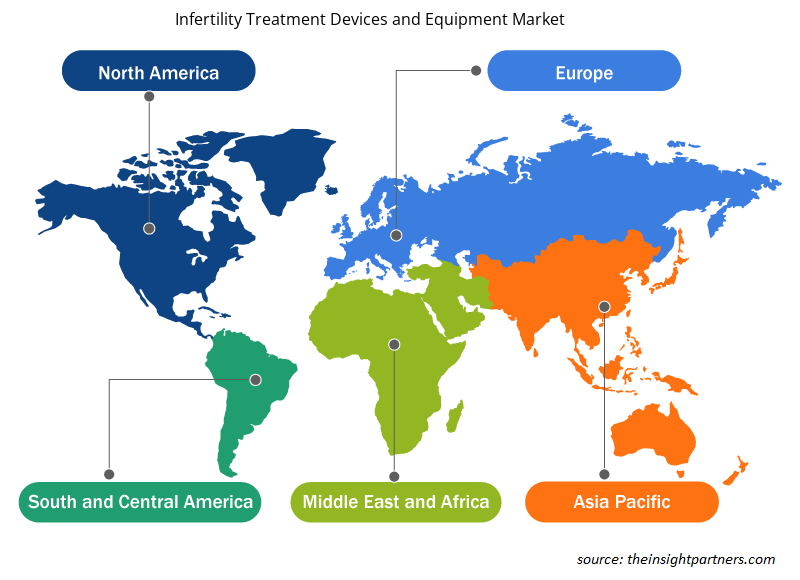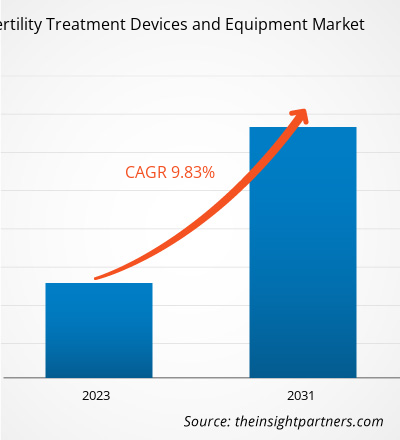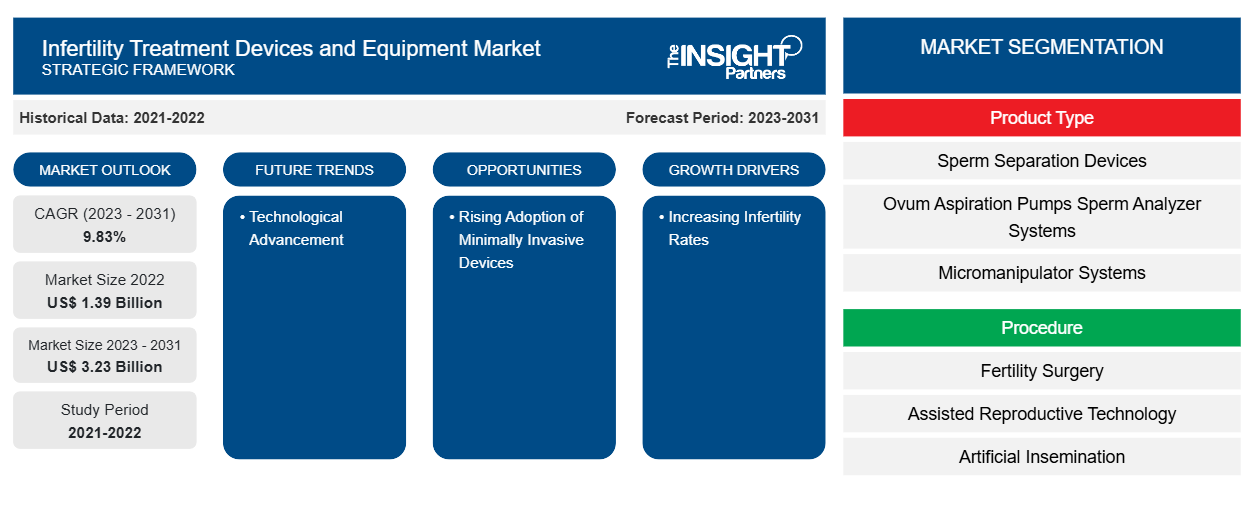Se proyecta que el tamaño del mercado de dispositivos y equipos para el tratamiento de la infertilidad alcance los 3230 millones de dólares estadounidenses en 2031, frente a los 1390 millones de dólares estadounidenses en 2022. Se espera que el mercado registre una CAGR del 9,83 % entre 2023 y 2031. Es probable que el desarrollo de nuevos tratamientos para la infertilidad, como la inyección intracitoplasmática de espermatozoides, siga siendo una tendencia clave en el mercado de dispositivos y equipos para el tratamiento de la infertilidad.
Análisis del mercado de equipos y dispositivos para el tratamiento de la infertilidad
La infertilidad es la incapacidad de concebir después de un año de relaciones sexuales sin protección. La Organización Mundial de la Salud (OMS) la ha reconocido como un problema de salud pública. El mercado mundial de dispositivos y equipos para el tratamiento de la infertilidad está experimentando un crecimiento significativo debido a diversos factores, entre ellos la disminución de la tasa de fertilidad mundial, la mayor tasa de éxito de las tecnologías reproductivas avanzadas y el creciente apoyo del gobierno y otras organizaciones sanitarias. Se espera que estos factores favorezcan el desarrollo de nuevos tratamientos para mejorar la fertilidad.
Descripción general del mercado de dispositivos y equipos para el tratamiento de la infertilidad
Según la OMS, casi el 17,5% de los adultos en todo el mundo padecen infertilidad. La prevalencia de la enfermedad a lo largo de la vida es del 17,8% en los países de ingresos altos y del 16,5% en los países de ingresos bajos y medios. El aumento de los casos de infertilidad conduce a un aumento del número de pacientes que buscan tratamientos de infertilidad. Esto pone de relieve la necesidad de una atención de la fertilidad asequible y de alta calidad, que contribuya a la expansión del mercado de dispositivos y equipos para el tratamiento de la infertilidad.
Personalice este informe según sus necesidades
Obtendrá personalización en cualquier informe, sin cargo, incluidas partes de este informe o análisis a nivel de país, paquete de datos de Excel, así como también grandes ofertas y descuentos para empresas emergentes y universidades.
- Obtenga las principales tendencias clave del mercado de este informe.Esta muestra GRATUITA incluirá análisis de datos, desde tendencias del mercado hasta estimaciones y pronósticos.
Impulsores y oportunidades del mercado de dispositivos y equipos para el tratamiento de la infertilidad
Las altas tasas de éxito de las tecnologías avanzadas de tratamiento de la infertilidad favorecen el mercado
Los tratamientos reproductivos han avanzado significativamente, ampliando las opciones y las tasas de éxito de los tratamientos de infertilidad como la tecnología de reproducción asistida (TRA). Según un artículo publicado en Cureus en octubre de 2022, en los próximos años, se prevé que la FIV se utilice ampliamente en múltiples regiones del mundo, lo que dará lugar al nacimiento de hasta el 10% de todos los niños y las tasas de éxito de la maduración in vitro (MIV) han aumentado hasta un 56% debido a los avances tecnológicos, la mejora de las herramientas necesarias y la experiencia y la formación acumuladas de quienes realizan el procedimiento. Además, los métodos de conocimiento de la fertilidad, como las aplicaciones de seguimiento de la ovulación , se han vuelto más accesibles y fiables, lo que permite tomar decisiones informadas sobre planificación familiar.
Dispositivos mínimamente invasivos: una oportunidad en el tratamiento de la infertilidad
Varias anomalías y afecciones, como los fibromas uterinos, las anomalías de Müller, los quistes ováricos y la endometriosis, pueden reducir las posibilidades de embarazo. Estos problemas también pueden causar efectos secundarios desagradables, como dolor pélvico crónico y sangrado abundante. La intervención quirúrgica puede ser el tratamiento más eficaz para estos síntomas en estos casos. La adopción de técnicas mínimamente invasivas, como la laparoscopia y la histeroscopia, puede abordar la causa subyacente de la infertilidad con una reducción del dolor, el tiempo de recuperación, el riesgo de infección y la pérdida de sangre. Los procedimientos implican el uso de pequeñas incisiones y cámaras de alta definición que proyectan el área de la operación en un monitor en lugar de las grandes incisiones abiertas que se utilizan en las cirugías convencionales.
Informe de análisis de segmentación del mercado de dispositivos y equipos para el tratamiento de la infertilidad
Los segmentos clave que contribuyen a la derivación del análisis del mercado de dispositivos y equipos para el tratamiento de la infertilidad son el tipo de producto, el procedimiento y el usuario final.
- Según el tipo de producto, el mercado de dispositivos y equipos para el tratamiento de la infertilidad se divide en dispositivos de separación de esperma, bombas de aspiración de óvulos, sistemas de análisis de esperma, sistemas de micromanipuladores, incubadoras y otros. El segmento de bombas de aspiración de óvulos tuvo la mayor participación de mercado en 2023.
- Por procedimiento, el mercado se segmenta en tecnología de reproducción asistida, cirugía de fertilidad e inseminación artificial. El segmento de inseminación artificial tuvo la mayor participación de mercado en 2023. Además, se espera que el segmento de tecnología de reproducción asistida registre la CAGR más alta entre 2023 y 2031.
- En términos de usuario final, el mercado está segmentado en clínicas de fertilidad, hospitales y otros centros de atención médica e institutos de investigación clínica. El segmento de clínicas de fertilidad dominó el mercado en 2023.
Análisis de la cuota de mercado de equipos y dispositivos para el tratamiento de la infertilidad por geografía
El alcance geográfico del informe de mercado de dispositivos y equipos para el tratamiento de la infertilidad se divide principalmente en cinco regiones: América del Norte, Asia Pacífico, Europa, Medio Oriente y África, y América del Sur y Central.
América del Norte ha dominado el mercado de dispositivos y equipos para el tratamiento de la infertilidad. Según el Departamento de Salud y Servicios Humanos de EE. UU., en 2021, alrededor del 2,3 % de los bebés nacidos en EE. UU. fueron concebidos mediante técnicas de reproducción asistida (TRA), con aproximadamente 413 776 ciclos realizados en 453 clínicas, lo que resultó en 112 088 embarazos. El creciente número de procedimientos de RA como la FIV, las crecientes tasas de infertilidad entre los hombres y la presencia de actores del mercado global son factores que contribuyen al dominio del mercado de dispositivos y equipos para el tratamiento de la infertilidad en América del Norte. Se prevé que Asia Pacífico crezca con la CAGR más alta en los próximos años.
Perspectivas regionales del mercado de equipos y dispositivos para el tratamiento de la infertilidad
Los analistas de Insight Partners explicaron en detalle las tendencias y los factores regionales que influyen en el mercado de dispositivos y equipos para el tratamiento de la infertilidad durante el período de pronóstico. Esta sección también analiza los segmentos y la geografía del mercado de dispositivos y equipos para el tratamiento de la infertilidad en América del Norte, Europa, Asia Pacífico, Oriente Medio y África, y América del Sur y Central.

- Obtenga datos regionales específicos para el mercado de dispositivos y equipos para el tratamiento de la infertilidad
Alcance del informe de mercado sobre dispositivos y equipos para el tratamiento de la infertilidad
| Atributo del informe | Detalles |
|---|---|
| Tamaño del mercado en 2022 | 1.390 millones de dólares estadounidenses |
| Tamaño del mercado en 2031 | US$ 3.23 mil millones |
| CAGR global (2023 - 2031) | 9,83% |
| Datos históricos | 2021-2022 |
| Período de pronóstico | 2023-2031 |
| Segmentos cubiertos | Por tipo de producto
|
| Regiones y países cubiertos | América del norte
|
| Líderes del mercado y perfiles de empresas clave |
|
Densidad de actores del mercado de equipos y dispositivos para el tratamiento de la infertilidad: comprensión de su impacto en la dinámica empresarial
El mercado de dispositivos y equipos para el tratamiento de la infertilidad está creciendo rápidamente, impulsado por la creciente demanda de los usuarios finales debido a factores como la evolución de las preferencias de los consumidores, los avances tecnológicos y una mayor conciencia de los beneficios del producto. A medida que aumenta la demanda, las empresas amplían sus ofertas, innovan para satisfacer las necesidades de los consumidores y aprovechan las tendencias emergentes, lo que impulsa aún más el crecimiento del mercado.
La densidad de actores del mercado se refiere a la distribución de las empresas o firmas que operan dentro de un mercado o industria en particular. Indica cuántos competidores (actores del mercado) están presentes en un espacio de mercado determinado en relación con su tamaño o valor total de mercado.
Las principales empresas que operan en el mercado de dispositivos y equipos para el tratamiento de la infertilidad son:
- Termo Fisher Scientific
- Grupo de cocina
- Vitrovida
- Tecnología de fecundación in vitro APS
- Compañía Hamilton Thorne Ltd.
- Esco Micro Pte Ltd
Descargo de responsabilidad : Las empresas enumeradas anteriormente no están clasificadas en ningún orden particular.

- Obtenga una descripción general de los principales actores clave del mercado de dispositivos y equipos para el tratamiento de la infertilidad
Noticias y desarrollos recientes del mercado de equipos y dispositivos para el tratamiento de la infertilidad
El mercado de dispositivos y equipos para el tratamiento de la infertilidad se evalúa mediante la recopilación de datos cualitativos y cuantitativos posteriores a la investigación primaria y secundaria, que incluye publicaciones corporativas importantes, datos de asociaciones y bases de datos. A continuación, se incluye una lista de los avances en el mercado de dispositivos y equipos para el tratamiento de la infertilidad:
- Trajan Scientific and Medical suministró dispositivos Mitra registrados con CE-IVD a Fertilly, una empresa emergente alemana. Fertilly lanzó los primeros kits de prueba de fertilidad para el hogar de Europa que utilizan micromuestreo de sangre seca con tecnología VAMS. Los dispositivos de micromuestreo Mitra permiten la recolección rápida y sencilla de muestras de sangre a través de punciones en el dedo, que luego se pueden enviar por correo a un laboratorio para su análisis como sangre seca. (Fuente: Trajan Scientific Australia Pty Ltd, comunicado de prensa, 2023)
- Merck Specialties Pvt ltd, la división de atención médica de Merck en India, lanzó Pergoveris Pen para el tratamiento avanzado de la infertilidad en India. Este lanzamiento enfatiza el motivo de la empresa de satisfacer necesidades médicas insatisfechas al brindar una opción de tratamiento combinado mejorada, conveniente y lista para usar para mujeres con deficiencia grave de hormona folículo estimulante (FSH) y hormona luteinizante (LH). (Fuente: Merck Specialties Pvt ltd, comunicado de prensa, 2021)
Informe sobre el mercado de dispositivos y equipos para el tratamiento de la infertilidad: cobertura y resultados
El informe “Tamaño y pronóstico del mercado de dispositivos y equipos para el tratamiento de la infertilidad (2021-2031)” proporciona un análisis detallado del mercado que cubre las siguientes áreas:
- Tamaño del mercado y pronóstico a nivel global, regional y nacional para todos los segmentos clave del mercado cubiertos bajo el alcance
- Dinámica del mercado, como impulsores, restricciones y oportunidades clave
- Principales tendencias futuras
- Análisis detallado de las cinco fuerzas de Porter y PEST y FODA
- Análisis del mercado global y regional que cubre las tendencias clave del mercado, los principales actores, las regulaciones y los desarrollos recientes del mercado.
- Análisis del panorama de la industria y de la competencia que abarca la concentración del mercado, el análisis de mapas de calor, los actores destacados y los desarrollos recientes
- Perfiles detallados de empresas
- Análisis histórico (2 años), año base, pronóstico (7 años) con CAGR
- Análisis PEST y FODA
- Tamaño del mercado, valor/volumen: global, regional y nacional
- Industria y panorama competitivo
- Conjunto de datos de Excel
Informes recientes
Testimonios
Razón para comprar
- Toma de decisiones informada
- Comprensión de la dinámica del mercado
- Análisis competitivo
- Información sobre clientes
- Pronósticos del mercado
- Mitigación de riesgos
- Planificación estratégica
- Justificación de la inversión
- Identificación de mercados emergentes
- Mejora de las estrategias de marketing
- Impulso de la eficiencia operativa
- Alineación con las tendencias regulatorias





















 Obtenga una muestra gratuita para - Mercado de dispositivos y equipos para el tratamiento de la infertilidad
Obtenga una muestra gratuita para - Mercado de dispositivos y equipos para el tratamiento de la infertilidad